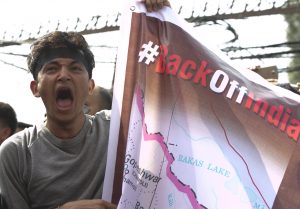In a speech at an election campaign rally in the northern Indian state of Uttarakhand on December 30, India’s Prime Minister Narendra Modi said that India had built and is expanding a road via disputed Lipulekh to Manas Khand, a gateway to Mansarovar, a Hindu pilgrimage site in Tibet.
While his speech was aimed at wooing Hindu voters in Uttarakhand, it created a furor in Nepal as the road he spoke about passes through Lipulekh, territory claimed by Nepal.
Following protests in Nepal, the Indian Embassy in Kathmandu issued a terse press release on January 15. India’s position on the boundary dispute was “consistent and unambiguous,” it said adding that New Delhi was of the view that “established inter-governmental mechanisms and channels were the most appropriate avenue for communication and dialogue.”
Nepal’s foreign ministry responded with a press statement on January 17. It reaffirmed Nepal’s claim over Limpiyadhura, Lipulekh, and Kalapani, and called on India to cease unilateral construction or development works in those territories. It also reiterated Nepal’s commitment to solving the issue diplomatically in the spirit of close friendly relations with India.
Nepal’s territorial dispute with India over Lipulekh came to the forefront in May 2015, when India and China agreed to develop transit and trade via the region. Nepal then sent diplomatic notes to New Delhi and Beijing protesting against the agreement, alleging violations of Nepal’s territorial integrity.
The issue resurfaced in November 2019 when India issued a new political map that included the disputed territories within India’s international borders. The issue united the Nepali public and parliamentarians against India’s occupation. The Nepali government, then led by Prime Minister Khadga Prasad Oli, amended the Nepali Constitution to include these disputed territories. India-Nepal relations, which had been under strain since 2015, when India imposed an unofficial economic blockade on Nepal, frayed further.
Current Prime Minister Sher Bahadur Deuba has remained silent in response to the controversy over Modi’s recent statement on Lipulekh. While his silence is partly due to the fact that several of his close associates and Nepal’s foreign secretary have tested positive for COVID-19, Deuba is also seen to be generally soft on India. He has been under intense pressure from the opposition, his coalition partners, and from within his party, the Nepali Congress, to speak up.
Although Deuba formed a committee to study Nepal’s border dispute with China — incidentally, both countries have denied the existence of a border dispute — he has not taken any similar initiative in the border dispute with India yet.
Nepal’s main opposition party, the Communist Party of Nepal-United Marxist Leninist (CPN-UML), which is led by Oli, has called for a stop to India’s road construction through Lipulekh. But it reserved its criticism for the Deuba government, accusing it of “suspicious silence on such a critical issue linked to [Nepali] nationalism.” As prime minister, Oli had burnished his nationalist credentials by publishing a new map that included the disputed territories.
Meanwhile, Nepali Congress General Secretaries Gagan Thapa and Bishwa Prakash Sharma issued a joint statement on January 14 describing the Indian action as objectionable and calling on India to stop the construction. They also called on Deuba to write a diplomatic note to India. Other leaders have also joined these calls. The Nepali Congress’ coalition partners urged the government to “take necessary measures to protect our territory.”
India’s insistence on the use of established inter-governmental mechanisms is an allusion to the secretary-level meetings tasked with addressing the boundary dispute. This is a delaying tactic on the part of New Delhi.
The boundary dispute is a political issue between the two states, and cannot be solved by secretary-level discussions. Moreover, Modi has refused to receive the final report prepared by the Eminent Persons’ Group (EPG) comprising of experts nominated by both countries. And finally, the status quo favors the Indian position; the disputed territory is under de facto Indian control.
Paradoxically, Nepal has not made any serious diplomatic effort to reach out to India to solve the territorial dispute in the aftermath of the constitutional amendment to include those territories in Nepal’s map. Consequently, there has been no change on the ground. Nepal could not access those areas to conduct the once-a-decade census after India declined to consent.
Nepal’s diplomatic positioning before and after the constitutional amendment in 2020 is geared toward domestic audiences and plays on the anti-Indian nationalist sentiment in the country. Political parties, more so when they are in opposition, raise the border issue but have consistently failed to take concrete steps to settle it when in power. The current episode could be no different. The CPN-UML has its eyes on upcoming elections in the way they criticize the government for its inaction.
The territorial dispute is a major flashpoint in India-Nepal relations, but the current episode is no more than an irritant. India-Nepal relations have withstood deeper tensions in the past without it having a major impact on the conduct of regular business between the two countries.
On February 1, for instance, India agreed to provide grant assistance to Nepal to build a motorable bridge across the Mahakali River. This is symbolic because the river marks the boundary between the two states, but the overlapping claims over the disputed territories stem from disagreement over the origin of the river. Additionally, the statements from both countries focus on a “diplomatic” solution to the issue, making any coercive changes in the status quo unlikely.
However, the risk in the long term is the rising anti-Indian nationalism in Nepal. If the public perception hardens because of territorial disputes, Nepali leaders will find it increasingly tough to conduct rational and sensible diplomacy with India. That would be a catastrophe.

































